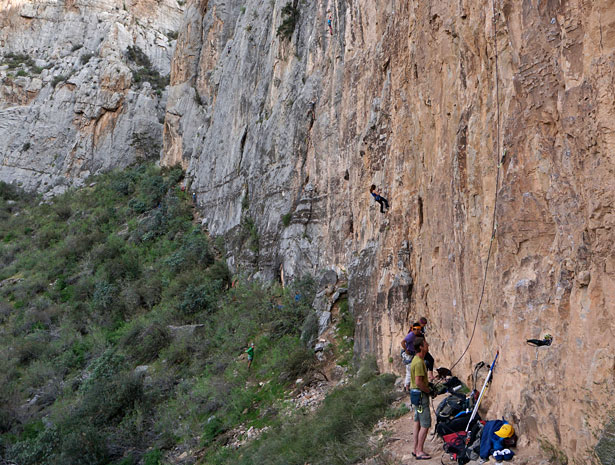The More You Know…
“People have no imagination for all the ways they can die. This is how we die, not finishing our knots and rappelling off the end of ropes!” – EH
Almost every spring, we spend a week or two in Red Rocks. I’ve got family there, and with basically every style of climbing you could ask for, it’s an ideal spot to get back in the swing of things for the spring season. It’s also incredibly popular, with all levels of climbers traveling to the sandstone mecca.
And that means you see shenanigans there that don’t tend to be as prevalent at crags that draw from a more elite crowd. The Roaring Fork Valley is kind of a weird place, in that most of the climbers here tend to be fairly experienced. You don’t see a lot of sketchy stuff out at the crags, and so when traveling to a place like Red Rocks or the Gunks, these things really stand out. Maybe everyone else is just desensitized to it, but there’s some dangerous stuff going on out there!
We were climbing with our friend Emily who lives in Vegas, and she was commenting about an Enormocast episode where the discussion touched on people who got offended because someone wanted to check their knot. She couldn’t believe this would ever be an issue, as she stated above, this is how we, as climbers, die or get seriously injured. We forget to tie our knots and we rap (or get lowered) off the end of ropes.
That got me thinking about how there is this pervasive nonchalance that can accompany climbing. Because most of the time we go out and nothing bad happens, we just start to assume that nothing bad EVER happens, even though we might just be getting lucky and not actually doing things right. While not as pronounced as in backcountry skiing, this false positive feedback of our skills lulls many people into thinking they know what they are doing, when the truth is that maybe they’ve just been getting away with bad habits for a long time. And from what I’ve seen, much of the time it comes down to people who aren’t open to feedback on their systems, or who don’t feel comfortable asking others for help if they aren’t sure how to do something.
Perhaps the most striking example of this was witnessed by my wife, Tracy, on the Solar Slab formation. We were climbing with friends who had never been to Red Rocks, and were moving as two groups of two, on two different routes that met up on the big ledge before Solar Slab proper. From there we’d climb two different routes that joined at the top and then combine our ropes to rap down. A pretty casual day for us and we were stoked to be showing our friends the area.
My partner and I reached the big ledge first, and waited for the girls for what seemed like a really long time. I thought maybe the climbing on their route was harder than they thought, but the truth was they encountered a scary situation and had to intervene.
Tracy was nearing the top of her second pitch when she looked over to see something that immediately looked wrong. The leader on the route next to them was belaying her partner up the first pitch of Johnny Vegas, but something was rotten in Denmark. The leader was clipped to the anchor bolts with just a daisy chain, which has it’s own issues, but the biggest problem was that she was belaying her second off one tipped out red Camalot, with an ATC that was not in guide mode. And as she was taking in rope, she was coiling it around her neck.
Tracy climbed over to her, set up a solid anchor, and put the second on belay, while talking this person through the problems with her setup. She was grateful, saying she’d never done a multipitch before, a fact she had neglected to tell her partner. This person didn’t know what they were doing, but they let their partner believe they did, which could have ended in a disastrous manner. It’s easy to judge and say she was foolish for doing so, but this kind of thing isn’t uncommon with less experienced climbers.
There’s this sense in our culture that to ask for help means showing weakness, or that the cool kids wont talk to you. I can guarantee you going splat at a crowded cliff is much more of a faux pas then asking someone to go over the basics of cleaning a sport climb before casting off into the unknown, or double checking the plan with your partner before you cast off on a multipitch endeavor
Climbing is awesome, but one mistake can change, or end, your life forever. Let’s all look out for eachother out there, and speak up when we aren’t sure how to do something. Be curious, embrace a learning mindset, and most of all be safe so you can enjoy it for many years to come.
One Response to The More You Know…
Bulldog Creek Dog Walk (IV WI 4+)
Hayden Carpenter and Tom Bohanon recently repeated an obscure ice climb on the south side of Mt Sopris. Given a brief mention in Jack Robert’s ice guide, Bulldog Creek Walk is described as being 100 meters of WI 4. What they found was seven pitches of ice in a remote setting that makes for one […]
Connect with Us
















Glad you pictured the grail. Good example of a place where you check you knots